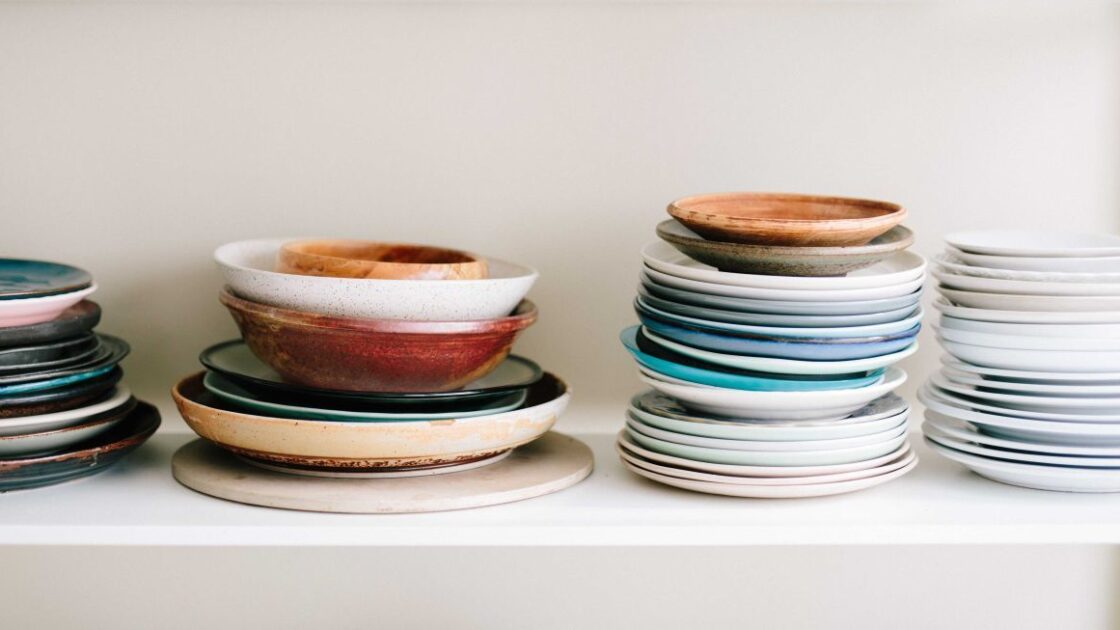
*Our test kitchen independently evaluates and reviews products for the OA community. If you click on the links provided, we may receive compensation which helps to keep the lights on. Learn more.
Is melamine safe like the FDA claims? In a word, no. You work hard to fill your plates and bowls with healthy organic food. You may even research non-toxic bakeware and which cookware brands keep toxins out of your food. Too bad that seemingly innocuous (and often very cute) tableware you’re munching off of could be disrupting your efforts to keep chemicals out of the kitchen.
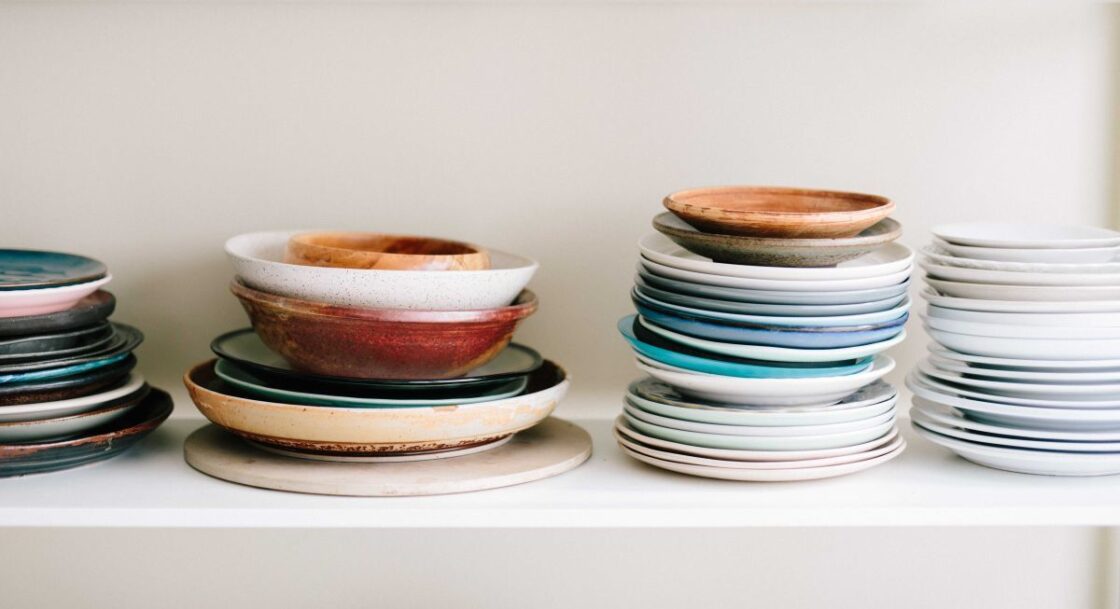
In the U.S., melamine is used to manufacture the following:
- Plastic products
- Industrial coatings and glues
- Paper and paperboard
- Countertops
- Dry erase boards
- Fabrics
- Flame retardants
Melamine is also one of the major components in the pigment yellow 150 (a colorant for inks and plastics).
If you’re wondering where kitchenware comes in, well, so are we. But nonetheless, melamine is used to make bowls, plates, utensils, mugs, and more.
In other countries, melamine is even used as a fertilizer, although it’s not “registered” for that use in the U.S., according to the FDA. Melamine is also the very same chemical found in tainted baby formula that killed six babies in China in 2008 and sickened thousands more.
Want more science-based deep dives? Sign up for the newsletter for more well-researched, non-toxic living guidance and smart wellness advice.
Read on to learn if or how melamine could be considered safe (i.e. is melamine toxic?), and what to use instead.
If you want more info on what’s really going into the stuff you use to prepare and serve your food, you’ll want to read our many breakdowns. Find out what the deal with stainless steel and how it’s different from carbon steel and cast iron. And checkout this guide on our tested and preferred picks for ceramic cookware.
What Is Melamine Made Of, Is It the Same as Plastic?
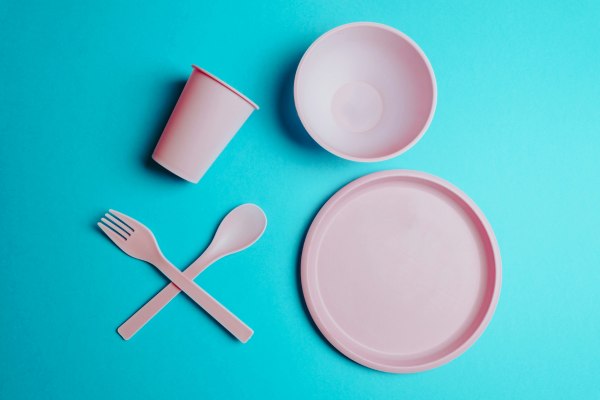
You’ve probably seen (or used) melamine dishes, even if you may not be familiar with the name. Melamine plates, bowls, and cups are hard plastic dishes that are extremely durable, crack-proof and come in a wide array of shapes, colors and patterns. They have a distinct smooth texture.
So what is it?
Melamine is an organic base manufactured through a commercial process. It starts with a molecule called urea, which is chemically broken down into cyanic acid. This reaction isn’t perfect, and other byproducts like cyanuric acid, ammeline, and ammelide are also formed.
Here’s where melamine gets interesting for industry. When combined with formaldehyde(!), melamine undergoes a chemical reaction that transforms it into two useful products:1
Melamine resin: A highly durable thermosetting plastic. Unlike some plastics that can melt with heat, thermosetting plastics permanently harden after their initial formation. This makes melamine formaldehyde resin ideal for a variety of applications such as countertops and laminates.
Melamine foam: A polymeric cleanser, meaning it’s a cleaning product composed of long, chain-like molecules. Melamine foam’s unique structure allows it to trap dirt and grime, making it effective for scrubbing stubborn stains.
“Although the clinical significance of what levels of urinary melamine concentration has not yet been established, the consequences of long-term melamine exposure still should be of concern,” wrote the study’s authors, led by Dr. Chia-Fang Wu, a researcher at Kaohsiung Medical University in Taiwan.
Is Melamine Safe to Microwave?

You probably want to know whether melamine is safe to use in the microwave and whether melamine dishes can potentially pose health risks by leaching chemicals into your food. Especially since we already know microwaving food in plastic containers (even microwave-safe plastic) is a health no-no.
The FDA notes that the risk level of melamine seeping into food from tableware is low, and that melamine can be used so long as you don’t use it to heat food, especially acidic food. So that’s a definitive no for using your melamine plates in the microwave! It’s also one hell of a caveat considering how necessary and convenient it is to reheat leftovers and considering how many foods are acidic!
A January 2013 study published in JAMA Internal Medicine found that melamine can leach from dishes into food and, consequently, your body if you use melamine tableware with hot foods. The study looked at 12 individuals. Albeit a small sample size, six ate hot soup for breakfast out of melamine bowls and the other six ate it out of ceramic bowls. The study found higher levels of melamine excreted from the individuals’ urine after using a melamine bowl as opposed to a ceramic bowl.
The FDA notes that the risk level of melamine seeping into food from tableware is low, and that melamine can be used so long as you don’t use it to heat food, especially acidic food.
“Although the clinical significance of what levels of urinary melamine concentration has not yet been established, the consequences of long-term melamine exposure still should be of concern,” wrote the study’s authors, led by Dr. Chia-Fang Wu, a researcher at Kaohsiung Medical University in Taiwan.
As the study’s authors note, this study didn’t look at any potential health risks associated with using melamine tableware—just that the chemical can leach into food from the dishes. In high concentrations, melamine exposure can put people at risk for kidney stones, kidney failure and even death.
What the FDA Says
In a safety and risk assessment, the FDA studied melamine migration from tableware and found it to be minimal under normal use conditions. While the FDA says melamine dinnerware is generally okay for serving food, there are some situations where it can be risky like those listed above. The key concern is when for melamine exposure, is melamine migration — when it leaches, out of the plastic and into your food.
But what does that mean for your health?
These conditions can cause enough harmful chemicals to seep into your food and potentially cause harm. The dangers include kidney problems like kidney stones or even failure.1 In severe cases, melamine poisoning can be fatal.
So, while melamine bowls may be pretty, it’s best to avoid using them with hot or highly acidic foods to stay on the safe side. If you’re concerned about possible melamine poisoning, speak to your doctor if you have signs of a kidney infection like little to no urine or blood in your urine. High blood pressure can also be a sign of melamine poisoning.
What Are the Risks?
While generally safe at low levels, high doses of melamine can be harmful to the kidneys — especially for children. This is because melamine can form crystals that irritate the kidneys and lead to kidney stones.2
In 2007, the dangers of melamine contamination and melamine toxicity came to light in a shocking way. A widespread pet food poisoning incident, known as “pet food-induced nephrotoxicity,” caused numerous cases of acute kidney failure in dogs and cats across North America.2
Just like a recent melamine-tainted milk scandal in China, the culprit in this pet food issue was melamine, added to fraudulently inflate the protein content. In addition to melamine in this case, the pet food was also contaminated with cyanuric acid, another toxic compound. Cyanuric acid, used to stabilize chlorine in swimming pools, is structurally similar to melamine.2
While the exact source of the cyanuric acid contamination remains a mystery (either intentional addition or a byproduct of melamine synthesis), its presence alongside melamine significantly increased the death rate among affected animals.
What to Buy Instead of Melamine

Perhaps you are taking inventory of your mish-mash of tableware accrued over time and realize it’s time to switch to quality tableware that is safe, durable and aesthetically appealing.
One melamine ware alternative that you may not have considered – stainless steel. This stuff is practically indestructible so no worries about little hands sending plates flying. Plus, it’s totally non-toxic and won’t leave any funky tastes in your food. Bonus points for being infinitely recyclable!
If you are looking to go au natural, consider bamboo or wheatstraw. These materials are lightweight and come from renewable sources. Just make sure they’re bonded with a safe, BPA and melamine-free resin to keep them sturdy.
For a more classic look, we love glass and stoneware. Glass is gorgeous and easy to clean (and also recyclable) while stoneware can run the range from rustic to chic. Both are free of nasties like BPA and melamine.
OA Approved Made In Tableware
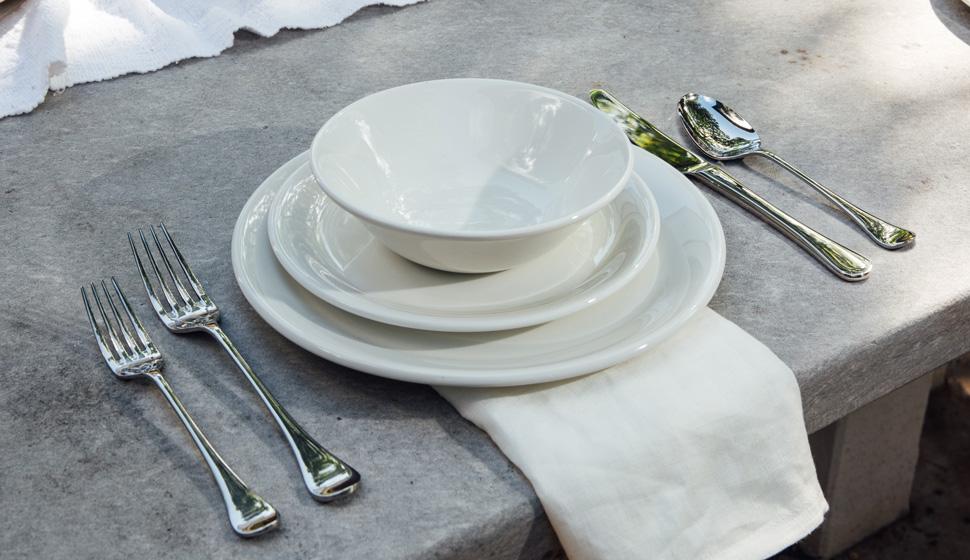
Whether you’ve recently moved into a new home, just renovated your kitchen, or simply want to be health conscious, Made In’s porcelain tableware is a favorite around here.
It is made in England from high-quality clay that is fully vitrified, making it highly durable and completely non-porous (keeping out water and bacteria). Fully glazed, these plates are protected from scratches from your forks and knives and are dishwasher safe, microwave safe, freezer safe, and won’t leach toxic chemicals (like melamine) even when reheating that tomato soup in the microwave.
You can pick up sets of four items here and there, or you can overhaul your whole setup in one fell swoop with their Tabletop Set (details below).
$119* – 4-Piece Entree Bowls
$109* – 4-Piece Dinner Plates
$599* – Tabletop Set – 4 each: Dinner, Appetizer, and Bread and Butter Plates, plus 4 Entrée and Side Bowls, a Serving Platter, and a full 20-Piece Flatware Set
*Prices are as listed at time of publish and are subject to change.
Made In’s cookware is pretty awesome too, it’s professional grade. Read our review and interview with the founders.
Editor’s Note: Fun fact, both “porcelain” and “china” describe the same type of ceramic ware. The term “porcelain” is more commonly used in Europe while “china” is more commonly used in the United States.
Melamine FAQs:
Is Melamine Dishwasher Safe?
The dishwasher safety of melamine can be a bit tricky. While some melamine dinnerware is labeled as dishwasher-safe, it’s important to exercise caution. Here’s the bottom line – it’s generally safe, with limitations.
Many reputable manufacturers produce melamine plates that can withstand the dishwasher on the top rack. However, high heat can still cause leaching, so it’s best to avoid using the high-heat drying cycle. This said, always refer to the manufacturer’s instructions printed on your specific melamine dinnerware. Look for dishwasher safety symbols and any temperature limitations they may specify.
Even dishwasher-safe melamine might pose a risk for hot meals or acidic dishes like tomatoes or vinegar. In these cases, it’s safer to opt for alternative dinnerware materials like glass, stainless steel, or stoneware.
When in doubt, we say play it safe and hand wash your melamine tableware.
Is melamine BPA free?
Melamine itself is not BPA (Bisphenol A). BPA is a separate chemical used in the production of some plastics. However, there are some things to consider.
Even though melamine isn’t BPA, some manufacturers might add BPA resins to their melamine products for added durability or heat resistance. If you must go with melamine dinnerware, to ensure yours is truly BPA-free, choose products with clear labeling stating “BPA-free.”
While a BPA-free label is a good sign, it’s still wise to research the manufacturer’s reputation and any potential alternative chemicals used in their BPA-free resins.
Bottom line – melamine may contain BPA.
Is Melamine Recyclable?
Technically, yes, melamine can be recycled. However, due to the fact that it’s a complex and complicated process, it rarely is.3 Not only that, melamine products often contain other materials, like laminates and adhesives, making recycling more difficult.
So, while technically possible, most melamine ends up filling up landfills. Try to find new ways to reuse your melamine dishes in your home before trashing them. Maybe use a bowl to hold jewelry, or nestle plates under potted plants to catch extra water? Get creative!
Conclusion: Is Melamine Safe?
To wrap things up, while the FDA considers melamine to be “relatively” safe, researchers state the need to study long-term exposure. And until we know more, why bother with the stuff? If you find yourself using melamine dishes to reheat your leftovers in the microwave, we think it’s time to shop for some real tableware.
P.S. Did you know? Organic Authority has its own nutrition and wellness shop to meet your needs and help you take control of your health. Shop clean supplements for energy, sleep, inner beauty for skin support, protein, workouts, pantry items and more. Shop The Organic Authority Shop now.
More to Read on Organic Authority
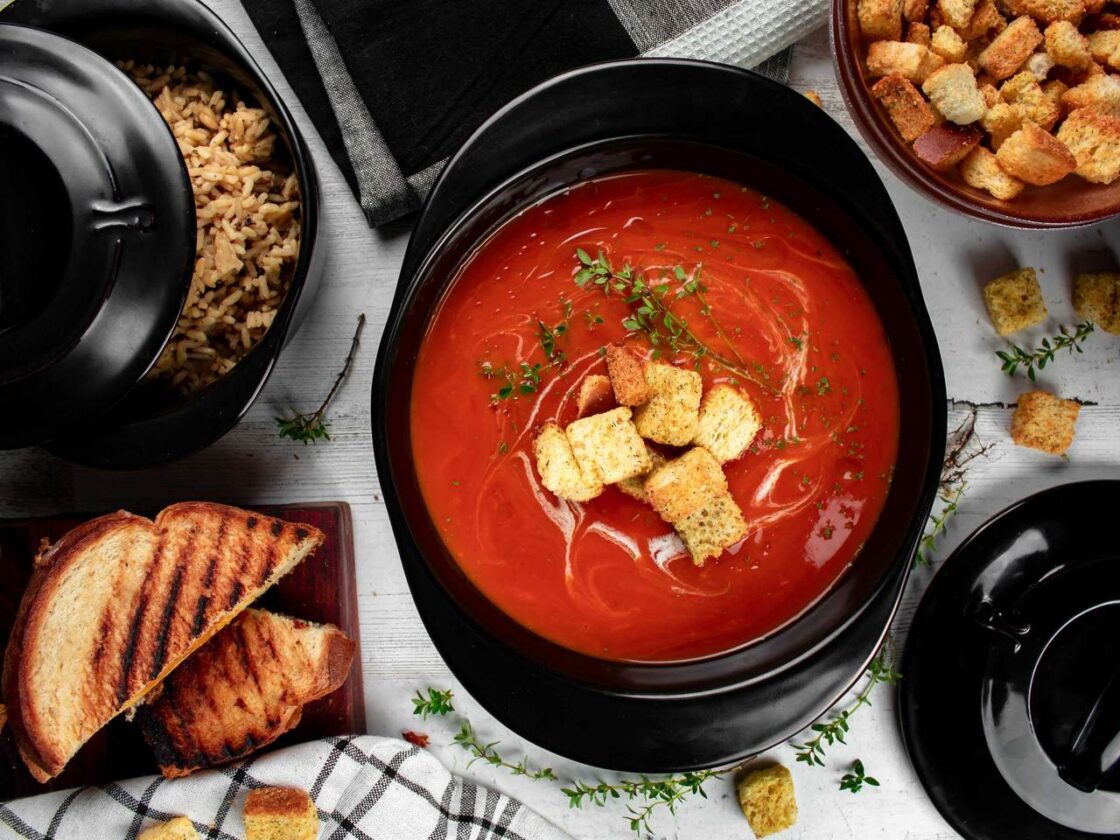
For Non-Toxic Nonstick Cookware, These 5 Sets from GreenPan Are No-Brainers
We’re Head Over Heels for This Gorgeous Non-Toxic, Nonstick Cookware Line
Xtrema Cookware Reviewed & Tested: Ceramic Cookware at It’s Best
*Our test kitchen independently evaluates and reviews products for the OA community. If you click on the links provided, we may receive compensation which helps to keep the lights on. Learn more.
Sources:
1. https://www.fda.gov/food/economically-motivated-adulteration-food-fraud/melamine-tableware-questions-and-answers
2. https://journals.lww.com/jasn/fulltext/2009/02000/melamine_toxicity_and_the_kidney.6.aspx#:~:text=With%20the%20best%20available%20evidence,by%20smaller%20body%20size%2C%20higher
3. https://www.recycledplastic.com/melamine/

